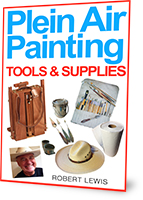Plein Air Painting Large
It is not common to see a plein air painter standing in front of a large canvas. The typical canvas size has become 14”x11” and often 20”x16”. Plein air painting large on location is a challenge and so seeing artists working on larger canvases are rare. There are good and obvious reasons for this:
- Wind (Lewis’ Laws of Painting #5: A canvas is a sail, a larger canvas is a larger sail.)
- Time. It just takes a lot longer to cover more square inches with paint.
- Expense. More paint, more expense.
- Exhaustion. It’s a lot of work to paint a large painting, even with large brushes.
While larger canvases are usually reserved for finished studio pieces, there are many fine plein air artists who paint big. Gear and minimizing fatigue are the key ingredients to this challenge.
The Gear
The “gloucester” style easel will work best for the larger painting. Take It Easel brand easel is a revival of the Anderson easel. According to Take It Easel, it was made popular by Emile Gruppé and the Gloucester school of painting as an answer to their need for a stable easel for plein air painting in windy conditions on the New England coast. It should be noted that while the Gloucester will hold very large canvases it can also hold small canvases, down to 5”x7”. It is an all around perfect plein air easel. It does require a painting box which sits on the horizontal braces.

David Lussier painting with a Gloucester-style easel in Sedona, Arizona. Note that although he is painting a small canvas, the gloucester’s design allows it to hold huge canvases for plein air painting large on location.
So, Gloucester-style easels address the problem of wind very nicely since they are specifically designed to be stable in windy conditions, having a very wide stance and the ability to hold large canvases securely.
Now, a Gloucester is not required. You might find that your French easel or other easels can accommodate larger canvases and, by adding screw eyes near the tips of the legs, the French easel can be staked down with tent stakes. Of course, you do not even need an easel. Some artists sit on the ground and just prop their canvases up the best they can. This will work for a large canvas, but your painting is in danger of picking up dust, gravel, and organic matter. But there is always a way to get things done if you use a little ingenuity. In the case of large canvases, the Gloucester is the most stable, reliable and convenient method.
There is little you can do about the expense, however. A Gloucester, unless it is your only easel, is an added expense. Larger canvas, more paint, and the added cost of a special easel, all add up.
Minimizing Fatigue
Exhaustion is something every painter feels after a few hours standing in the hot sun focusing with great attention. Increase the size of the canvas and what happens? You increase the square footage that needs to be covered. You increase the amount of paint that needs to be mixed. You increase the amount of eye movement. You make it necessary to step back further now and then. On a 14”x11” canvas you spend three hours. A 20”x30” canvas is four times larger but you still only have three hours. Multiply your exhaustion by four, that is, if you paint in the same way. You can not paint the same way; you need a strategy.
To minimize your fatigue, preparation is the strategy. You want to save enough energy to finish nicely, so do all of the prep work, the foundational work, as fast as you can. Here are some suggestions…
- Tone your canvas in the studio, not on location.
- Save time on location by mixing all the basic colors you will need and mixing enough for the entire painting. Do this before starting to paint. Do it at home if possible.
- Simplify. Decide what to leave out. Determine your point of focus. Stick with it.
- Sketch your composition fast.
- Rough in your masses quickly with large brushes
- Use your pre-mixed paints loosely. This will help create an energetic painting.
Finally, with the time and energy you have saved above, finish the painting with details, always starting at the focal point and working outward from it.
This strategy saves time in the beginning of the painting process. The goal is to get you through the foundational phase quickly so that you are left with plenty of time and energy for the finishing phase where you put in the details and finish the painting with good brushwork.







